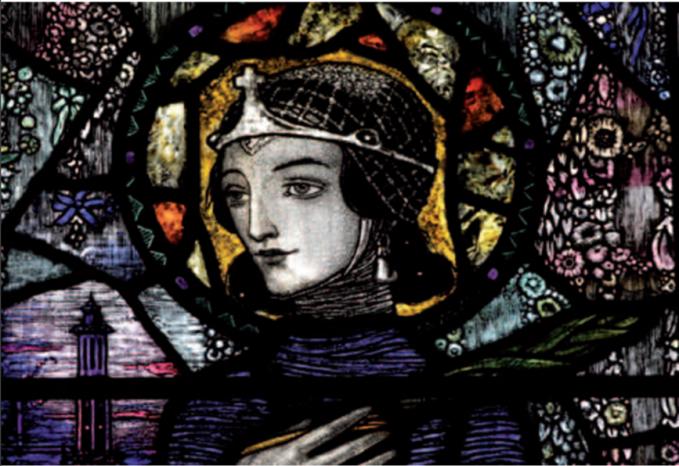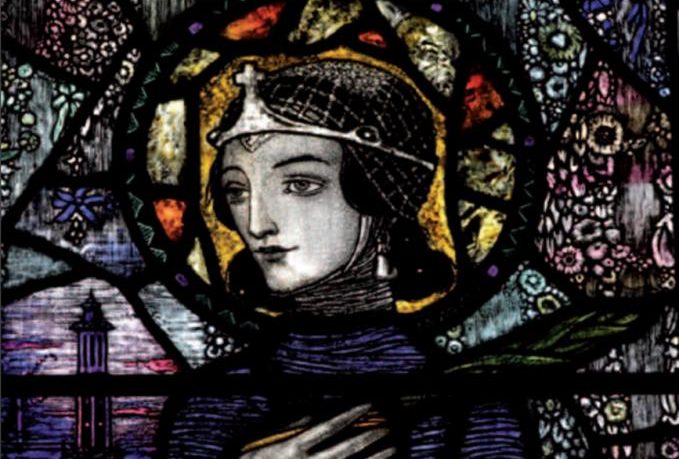The name of Harry Clarke is synonymous with quality craftsmanship and imaginative genius. His use of deep rich colours, his delicate depiction of beautiful elongated figures with their finely carved features and deep expressive eyes, is indeed magical to behold. During his short life, Clarke created stained-glass windows for churches throughout Ireland and England, and as far afield as the United States of America and Australia.


One of Harry Clarke’s works in a church in Dorset, UK
Clarke was also an illustrator of books for George G. Harrap & Co. London, and these works testify that his genius extended into the area of graphic art. Stained glass is a breathtaking medium in which to admire a beautiful creation, yet the great limitation of photographing stained glass is that no reproduction can ever capture the dazzling, magical effect created by light streaming through a stained-glass window.
Early Years
Harry attended Marlborough Model School and later the Jesuit Belvedere College, located just around the corner from his home in North Frederick Street, Dublin. Belvedere College was typical for its time, in that religion was taught in a strict manner whereby hell and damnation awaited unrepentant sinners while salvation in the next life was assured to those who lived a life of penance and piety. A few years earlier James Joyce had attended Belvedere and it became the setting for his book A Portrait of the Artist as a Young Man.


Detail of the bottom feature of the right light of the fifth window in the south aisle, depicting St Patrick preaching to his disciples including Benignus as a young boy (left side). This stained glass window was created by Harry Clarke in 1925.
It is often surmised that the effect on the sensitive young Harry of this zealous doctrine was acute. Although Clarke is famous for his delicate portrayal of beautiful saints, angels, and heroines in his stained-glass work, some of his later book illustrations show a fascination with the sexually decadent and macabre, and may reflect the medieval dualism of his early religious indoctrination.
In 1904, Clarke left school and became apprenticed to an architect. This position was of short duration, however, as in 1905, Clarke became apprenticed to his father’s studio. It was here that he spent five years learning the craft of stained glass from Dublin craftsman William Nagle.


This stained glass window depicts the Beheading of John the Baptist by Harry Clarke, created in 1925.
At the age of fifteen, Clarke began taking night classes in stained glass at the Dublin Metropolitan School of Art. In 1911, Clarke won a gold medal from the Board of Education National Competition at South Kensington, London, for his window The Consecration of St Mel, Bishop of Longford, by St Patrick. Over 13,000 works were submitted by students for these competitions and only two Irish students were awarded gold medals. This was the first of three consecutive gold medals that Clarke won at the National Competitions for his stained-glass work. At the Dublin Metropolitan School of Art, Clarke met Margaret Crilly, a gifted artist and teacher, originally from Newry, County Down. In many ways Margaret was the opposite of Clarke. Whereas Clarke was tall and thin, prone to poor health, highly sensitive and imaginative, Margaret was small, physically robust, and of a practical disposition. To the surprise of many, the pair married on 31 October 1914 and moved into a flat at 33 North Frederick Street.


This window has been designed by Harry Clarke in 1924 and is titled The Agony in the Garden. It was installed in the Presentation Convent Chapel (designed by C. J. McCarthy in 1886) which is now the Institute of Education and Celtic Culture in Dingle, County Kerry.
First Commissions
Clarke soon set about getting commissions for illustrations and stained glass. Laurence ‘Larky’ Waldron, stockbroker, Nationalist MP, Governor of the National Gallery of Ireland and Governor of Belvedere College, became an influential friend and patron of Clarke’s from the summer of 1912 until Waldron’s death in December 1923. Clarke became a frequent visitor at Waldron’s home ‘Marino’, at Ballybrack, overlooking Killiney Bay. It was there that the young artist was introduced to many of Dublin’s intelligentsia.
Waldron gave Clarke his first commission in book illustration, in 1913, to illustrate Alexander Pope’s The Rape of the Lock. Clarke also began experimenting with stained-glass panels inspired by literary themes. He created a series of nine panels for Waldron based on John Millington Synge’s ‘Queens.’ The panels were set in wrought-iron frames that were made by Dublin furniture designer James Hicks, who also attracted Waldron’s patronage. The delicacy, rich colours, and fine craftsmanship of these panels won Clarke’s international acclaim.


The south-east aisle window in St Mary’s Church, Sturminster Newton, by Harry Clarke of Dublin, 1921.
Clarke’s studies at the Dublin Metropolitan School of Art were completed in 1913 and he decided to rent a studio in London. While there, he began his search to secure a publisher for his book illustrations. After traipsing around London and being rejected by several eminent publishers, Clarke finally arrived at the door of George G. Harrap. In his memoirs, Harrap described his first meeting with Clarke, ‘He came into my room late in the afternoon, slim, pale and youthful, with the air of one who has had rebuffs. He opened his portfolio very shyly, and with delicate fingers drew out his lovely drawings.’
By Christmas of 1913 Clarke had secured his first commission from Harrap, to illustrate Hans Christian Andersen’s Fairy Tales. It was published in 1916. At this point, Clarke gave up his London studio and returned to Dublin. As part of the scholarship he had been awarded by the Department of Agriculture and Technical Instruction, he travelled to France to visit Chartres Cathedral in January 1914.


Bottom panel of the left light of the fifth window in the south aisle, depicting St Rose burning her hands in an act of penance. This stained glass window was created by Harry Clarke in 1925. The inscription reads: Pray for the souls of Dr Patrick Horne and his daughter Rose Rossiter, and for her son, Brendan
Then, when war was declared in August 1914, the supply of glass and lead from London dried up, which seriously affected Clarke’s business.
In October 1914, Sir John O’Connell, a governor at Belvedere College invited Clarke to submit designs for several windows for the Honan Chapel of St Finbarr, at University College Cork. Clarke won the commission and, between 1915 and 1918, created nine windows for the Honan Chapel. These magnificent windows were central to building a solid reputation for Clarke’s skilled draftsmanship and originality.
If you want read up about this often-overlooked Irish artist, you can buy a great book about him here.






